|
Time Travel Research Center ©
2005 Cetin BAL - GSM:+90 05366063183 - Turkey/Denizli
How to Survive the End of the Universe (In 7 Steps)
The cold, dark end is coming. We need an escape plan
By Michio Kaku
Illustrations by Don Foley
DISCOVER Vol. 25 No. 12 | December 2004 | Astronomy & Physics
Adapted from the book Parallel
Worlds: A Journey Through Creation, Higher Dimensions, and the
Future of the Cosmos, published this month by Doubleday. Copyright ©
2004 by Michio Kaku.
The universe is out of control. Not only is it expanding but the
expansion itself is accelerating. Most likely, such expansion can
end only one way: in stillness and total darkness, with temperatures
near absolute zero, conditions utterly inhospitable to life. That
became evident in 1998, when astronomers at the Lawrence Berkeley
National Laboratory and Australian National University were
analyzing extremely distant, and thus ancient, Type Ia supernova
explosions to measure their rate of motion away from us. (Type Ia
supernovas are roughly the same throughout the universe, so they
provide an ideal “standard candle” by which to measure the rate of
expansion of the universe.)
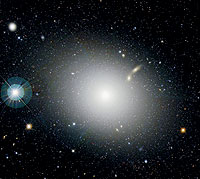
Courtesy of the Canada-France-Hawaii
Telescope/J.-C. Cuillandre/Coelum
|
Quote: |
There’s no time like the present to start planning our cosmic
egress. Scenes like this one, of the massive galaxy M87, will
become fleeting memories as the universe advances in age. Thanks
to dark energy, even the nearby galaxies will begin to recede
from us faster than light, and no news of them will reach us.
Eventually even the atoms will be too cold to move, and time
itself will freeze—too late for any straggling civilization.
|
Physicists, scrambling to their blackboards, deduced that a “dark
energy” of unknown origin must be acting as an antigravitational
force, pushing galaxies apart. The more the universe expands, the
more dark energy there is to make it expand even faster, ultimately
leading to a runaway cosmos. Albert Einstein introduced the idea of
dark energy mathematically in 1917 as he further developed his
theory of general relativity. More evidence came last year, when
data from the Wilkinson Microwave Anisotropy Probe, or WMAP, which
analyzes the cosmic radiation left over from the Big Bang, found
that dark energy makes up a full 73 percent of everything in the
universe. Dark matter makes up 23 percent. The matter we are
familiar with—the stuff of planets, stars, and gas clouds—makes up
only about 4 percent of the universe.
As the increasing amount of dark energy pushes galaxies apart faster
and faster, the universe will become increasingly dark, cold, and
lonely. Temperatures will plunge as the remaining energy is spread
across more space. The stars will exhaust their nuclear fuel,
galaxies will cease to illuminate the heavens, and the universe will
be littered with dead dwarf stars, decrepit neutron stars, and black
holes. The most advanced civilizations will be reduced to huddling
around the last flickering embers of energy—the faint Hawking
radiation emitted by black holes. Insofar as intelligence involves
the ability to process information, this, too, will fade. Machines,
whether cells or hydroelectric dams, extract work from temperature
and energy gradients. As cosmic temperatures approach the same
ultralow point, those differentials will disappear, bringing all
work, energy flow, and information—and the life that depends on them—to
a frigid halt. So much for intelligence.
A cold, dark universe is billions, if not trillions, of years in the
future. Between now and then, humans will face plenty of other
calamities: wars and pestilences, ice ages, asteroid impacts, and
the eventual consumption of Earth—in about 5 billion years—as our
sun expands into a red giant star. To last until the very end of the
universe, an advanced civilization will have to master interstellar
travel, spreading far and wide throughout the galaxy and learning to
cope with a slowing, cooling, darkening cosmos. Their greatest
challenge will be figuring out how to not be here when the universe
dies, essentially finding a way to undertake the ultimate journey of
fleeing this universe for another.
|
Quote: |
THINK SMALL
Stephen Hawking has suggested that it might be possible to
travel through a wormhole to another universe or another time.
This may allow an advanced civilization to evade the death of
the universe. Even if the wormhole is subatomic it might still
be possible to inject enough information through the wormhole
via nanotechnology to re-create the entire civilization on the
other side. |
Such a plan may sound absurd. But there is nothing in physics that
forbids such a venture. Einstein’s theory of general relativity
allows for the existence of wormholes, sometimes called Einstein-Rosen
bridges, that connect parallel universes. Among theoretical and
experimental physicists, parallel universes are not science fiction.
The notion of the multiverse—that our universe coexists with an
infinite number of other universes—has gained ground among working
scientists.
The inflationary theory proposed by Alan Guth of MIT, to explain how
the universe behaved in the first few trillionths of a second after
the Big Bang, has been shown to be consistent with recent data
derived from WMAP. Inflation theory postulates that the universe
expanded to its current size inconceivably fast at the very
beginning of time, and it neatly explains several stubborn
cosmological mysteries, including why the universe is both so
geometrically flat and so uniform in its distribution of matter and
energy. Andrei Linde of Stanford University has taken this idea a
step further and proposed that the process of inflation may not have
been a singular event—that “parent universes” may bud “baby
universes” in a continuous, never-ending cycle. If Linde’s theory is
correct, cosmic inflations occur all the time, and new universes are
forming even as you read these words.
Naturally, the proposal to eventually flee this universe for another
one raises practical questions. To begin with, where exactly would
an advanced civilization go?
As it happens, physicists are spending billions of dollars on
experiments to probe the nature of parallel universes. Since 1997,
scientists at the University of Colorado at Boulder have conducted
experiments to search for parallel universes perhaps no more than a
millimeter away from ours. The experiments searched for tiny
deviations in Newton’s inverse square law of gravity. The surface of
a sphere in three dimensions is equal to 4π times the radius squared.
Likewise, the surface of a sphere of higher dimensions is
proportional to the radius cubed. According to Newton’s law, in such
a sphere the measurable gravity should decrease as a factor of the
distance cubed. So the Colorado physicists set about measuring the
gravity within a small, defined space. If the gravitational force
deviated significantly from Newton’s equation (the distance squared)
and was more closely proportional to the distance cubed, the
research team theorized, that would suggest the presence of a hidden
dimension.
Newton’s inverse square law has been tested with exquisite precision
by space probes, but it had never been tested at the millimeter
level. So far, the results from these experiments have been negative,
but other scientists are looking for even smaller deviations. A
group at Purdue University has proposed testing Newton’s inverse
square law down to the atomic level using nanotechnology.
Physicists elsewhere are exploring other possibilities. In 2007 the
Large Hadron Collider, the world’s largest atom smasher, will be
turned on outside Geneva, Switzerland. This huge machine, more than
five miles in diameter, is capable of blasting protons together with
a colossal energy of 14 trillion electron volts; it will be able to
probe distances 1/10,000 the size of a proton, perhaps creating a
zoo of exotic particles not seen since the Big Bang. One hope is
that it will create exotic particles like miniature black holes and
sparticles, or supersymmetric particles, which would indicate the
presence of parallel universes in higher dimensions.
In addition, the space-based gravity-wave detector LISA (Laser
Interferometer Space Antenna) will be launched sometime around 2012.
It will consist of three satellites trailing Earth’s orbit around
the sun and communicating with one another via laser beams, thereby
creating a triangle with sides more than 3 million miles long. LISA
is designed to detect faint gravity waves from extremely far away—gravitational
shock waves that were emitted less than a trillionth of a second
after the instant of creation. The instrument is so sensitive that
scientists hope it will be able to test many of the theories that
seek to explain what happened before the Big Bang and probe for the
existence of universes beyond our own.
To journey safely from this universe to another—to investigate the
various options and do some trial runs—an advanced civilization will
need to be able to harness energy on a scale that dwarfs anything
imaginable by today’s standards.
To grasp the challenge, consider a schema introduced in the 1960s by
Russian astrophysicist Nikolai Kardashev that classified
civilizations according to their energy consumption. According to
his definition, a Type I civilization is planetary: It is able to
exploit all the energy falling on its planet from the sun (1016
watts). This civilization could derive limitless hydrogen from the
oceans, perhaps harness the power of volcanoes, and maybe even
control the weather. A Type II civilization could control the energy
output of the sun itself: 1026
watts, or 10 billion times the power of a Type I civilization.
Deriving energy from solar flares and antimatter, Type IIs would be
effectively immune to ice ages, meteors, even supernovas. A Type III
civilization would be 10 billion times more powerful still, capable
of controlling and consuming the output of an entire galaxy (1036
watts). Type IIIs would derive energy by extracting it from billions
of stars and black holes. A Type III civilization would be able to
manipulate the Planck energy (1019
billion electron volts), the energy at which space-time becomes
foamy and unstable, frothing with tiny wormholes and bubble-size
universes. The aliens in Independence Day would qualify as a Type
III civilization.
By contrast, ours would qualify as a Type 0 civilization, deriving
its energy from dead plants—oil and coal. But we could evolve
rapidly. A civilization like ours growing at a modest 1 to 2 percent
per year could make the leap to a Type I civilization in a century
or so, to a Type II in a few thousand years, and to a Type III in a
hundred thousand to a million years. In that time frame, a Type III
civilization could colonize the entire galaxy, even if their rockets
traveled at less than the speed of light. With the inevitable Big
Freeze at least tens of billions of years away, a Type III
civilization would have plenty of time to develop and test an escape
plan.
Why not start now? On the following pages are experiments and plans
to guide a civilization looking for a way out—a survival guide to
the end of the cosmos.
SEVEN STEPS TO LEAVING THE COSMOS
1- FIND AND TEST A THEORY OF EVERYTHING
Before an advanced civilization leaps into the unknown, it will need
to study the pathways that make it possible to break through to the
other side. Toward that end, scientists will need to discover the
laws of quantum gravity, which will help to calculate the stability
of wormholes connecting our universe to others.
At present, the leading—and, some believe, only—candidate for a
theory of everything is string theory, or M-theory. This theory
states that all subatomic particles are different vibrations or
notes on a tiny string or membrane. These aren’t ordinary strings
but rather strings that vibrate in higher-dimensional hyperspace. In
principle, our universe might be a huge membrane drifting in 11
dimensions, which may occasionally collide with a neighboring
membrane or universe. It is possible that our universe and a
neighboring one hover only a millimeter or less from each other,
like two parallel sheets of paper. To bridge even this tiny distance,
however, we’ll need machinery of vast power.
2- SEARCH FOR A NATURALLY OCCURRING WORMHOLE
Next, in order to escape from this universe into another one, we
will need to find a suitable exit: some wormhole, dimensional
gateway, or cosmic tunnel that connects here to there.
There are many possibilities, some of which may occur naturally. The
Big Bang, which released a tremendous amount of energy, may have
left behind all manner of exotic entities of physics, such as cosmic
strings, false vacuums, or negative matter or energy. The original
expansion of the universe may have been so rapid and explosive that
even tiny wormholes might have stretched and blown up to macroscopic
size. The discovery of such entities would greatly aid any effort to
leave a dying universe; if they exist, we would do well to find them.
Perhaps by the time the need arises, billions of years from now, an
advanced civilization will have stumbled upon one of these gateways.
In the meantime, we should consider a more proactive strategy.
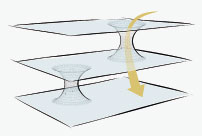
|
Quote: |
UPGRADE THE COMPUTER
Einstein’s equations allow for the existence of stacked,
parallel universes. But to calculate precisely what’s on the
other side of a wormhole will require gigantic amounts of
computer power, beyond anything available today. |
3- SEND A PROBE THROUGH A BLACK HOLE
Black holes offer another possible avenue of escape. One advantage
of black holes is that, as scientists now realize, they are
plentiful in the universe. The one at the center of our galaxy has a
mass more than 3 million times that of our sun. Of course, there are
numerous technical problems to be worked out. Most physicists
believe that a trip through a black hole would be fatal. Although
Einstein’s equations permit the possibility of passing through a
black hole, the quantum effects may be insurmountable. However, our
understanding of black hole physics is in its infancy, and this
conjecture has never been tested.
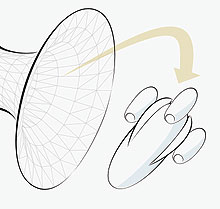
|
Quote: |
SAVE EARLY AND OFTEN
Before the probe falls into the black hole, it must radio its
data to observers waiting nearby. Here a problem arises. To the
observer, the probe seems to slow down as it nears the event
horizon and eventually stops entirely. So the probe must send
the last of its data early on; otherwise the radio signals may
be redshifted beyond recognition. |
A reasonable first experiment would be to send a test probe through
a black hole. Of course, any such venture would be a one-way trip;
every black hole is surrounded by an event horizon, a point of no
return beyond which not even light (and perhaps information) can
escape the immense gravitational pull. Knowledge could be gleaned
from the probe up to the moment it finally crosses the event horizon
and all contact is lost. An intense, and most likely lethal,
radiation field surrounds the event horizon. (Light rays gain
tremendous energy as they fall into a black hole.) A probe could
determine precisely how much radiation permeates this region—useful
data for subsequent missions.
A probe might also settle some critical questions about the
stability of black holes. In 1963 mathematician Roy Kerr showed that
a rapidly spinning black hole will collapse not into a dot but
rather a rotating ring that cannot break down because of centrifugal
forces. A Kerr ring has the same topology as Alice’s looking glass;
the wormhole at its center might connect our universe to other
points in the same universe or to an infinite number of parallel
universes. These parallel universes may be stacked on top of one
another like floors in an elevator skyscraper. Scientists disagree
over what happens if one enters a Kerr ring. For example, some say
that sending a probe in might destabilize the black hole, reduce the
event horizon to a singularity, and shut the wormhole altogether.
This controversy gained fuel in July when Stephen Hawking, reversing
a famous wager he’d made seven years ago, suggested that information
entering a black hole may not be irretrievably lost after all.
Throwing a probe into a black hole would disturb the Hawking
radiation it emits, he argues, and might permit information to leak
out. All the more reason to send a probe in and see what happens.
4- CREATE A BLACK HOLE IN SLOW MOTION
Once the characteristics near the event horizon of a black hole are
carefully ascertained by probes, the next step might be to create a
black hole in slow motion to gain further experimental data on the
characteristics of space-time.
In a 1939 paper, Einstein envisioned a swirling mass of stellar
debris slowly collapsing under its own gravity. He concluded that
such a mass alone could not contract on a large enough scale to form
a black hole, but he had not considered the now-familiar concept
that the object could implode. His work leaves open the possibility
that if one could slowly inject sufficient additional matter and
energy into the spinning system, one could kick-start an implosion
and create a black hole.
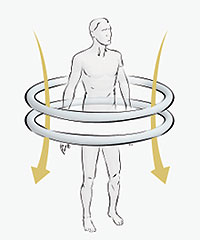
|
Quote: |
STIR GENTLY
The contraction of the neutron stars should be performed slowly,
lest the scientist set off a messy, supernova-like explosion.
Conducted properly, the process should create two Kerr rings,
one in this universe and one in another. |
Consider that a Type III civilization would be capable of corralling
matter on a galactic scale. To form a black hole, one might gather a
swirling collection of neutron stars, which are each about the size
of Manhattan but possess more mass than our sun. Gravity will
gradually bring the stars closer together, at which point our
advanced scientists might carefully add more neutron stars to the
mix. Once the total matter exceeds about three solar masses, the
combined gravity would force the stars to collapse into a spinning
ring—a Kerr black hole. Armed with a newfound ability to create and
study wormholes under controlled circumstances, future scientists
would greatly advance their knowledge of how wormholes form—and how
best to traverse them.
5- CREATE NEGATIVE ENERGY
If Kerr rings prove to be lethal or too unstable for use as cosmic
portals, an advanced civilization might instead contemplate opening
up a new wormhole by using negative matter or negative energy. (In
principle, negative matter or energy should weigh less than nothing
and fall up rather than down. This is different stuff from
antimatter, which contains positive energy and falls down.) In 1988
Kip Thorne and his colleagues at Caltech showed that with sufficient
negative matter or negative energy, one could create a wormhole
through which a traveler could freely pass back and forth between,
say, his laboratory and a distant point in space or time.
Although no one has yet seen negative matter or negative energy in
the wild, it has been detected in the laboratory, in the form of
something called the Casimir effect. Consider two uncharged,
parallel plates. Theoretically, the force between them should be
zero. But if they are placed only a few atoms apart, then the space
between them is not enough for some quantum fluctuations to occur.
As a result, the number of quantum fluctuations in the region around
the plates is greater than in the space between. This differential
creates a net force that pushes the two plates together. Hendrik
Casimir predicted the effect in 1948; it has since been confirmed
experimentally.
The amount of energy involved is minuscule. To employ the Casimir
effect to practical ends, one would have to use advanced technology
to place the parallel plates at a fantastically small distance apart—10–33
centimeter, the Planck length (the smallest measurement of length
with any meaning). Now suppose that these two parallel plates could
be shaped into a single sphere, with the plates forming a sort of
double lining, and pressed together to within this fractional
distance. The resulting Casimir effect might generate enough
negative energy to open a wormhole within the sphere.
6- MAKE A BABY UNIVERSE
If both Kerr rings and negative-energy wormholes prove unreliable,
Guth’s inflation theory points the way to another, more difficult
escape strategy: creating a baby universe.
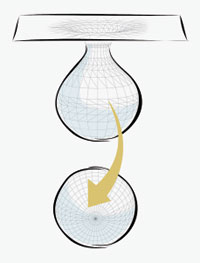
As Guth points out, to create something resembling our universe
would require “1089 photons, 1089 electrons, 1089 positrons, 1089
neutrinos, 1089 antineutrinos, 1079 protons, and 1079 neutrons.”
However, Guth notes, the positive energy of this matter is almost
but not entirely balanced out by the negative energy of gravity. (If
our universe were closed, which it isn’t, the two values would
cancel each other out exactly.) In other words, the net total matter
required to create a baby universe might equal only a few ounces.
But what ounces! In principle, baby universes are born when a
certain region of space-time becomes unstable and enters a state
called the false vacuum. The false vacuum needed to create our
universe is extraordinarily small, on the order of 10–26 centimeter
wide. If one created this false vacuum from one ounce of matter, its
density would be a phenomenal 1080 grams per cubic centimeter.
Acquiring a few ounces of matter is easy; compressing it into the
small volume necessary is not possible today.
The solution requires that a fantastic amount of energy, roughly
equal to the Planck energy, be concentrated on a tiny region. Here
are two approaches an advanced civilization might try.
BUILD A LASER IMPLOSION MACHINE
The power of laser beams is essentially unlimited, constrained
mainly by the stability of lasing material and the energy of the
power source. Lasers that can produce a brief terawatt, or trillion-watt,
burst are commonplace, and petawatt lasers capable of generating a
quadrillion watts are possible. By contrast, a large nuclear power
plant produces only a billion watts of continuous power. It is
theoretically possible for an X-ray laser to focus the output of a
nuclear bomb to create a pulse of unimaginable power.
At the Lawrence Livermore National Laboratory, scientists have used
a laser to fire a series of high-energy pulses radially onto a
single pellet made of deuterium and tritium, the basic ingredients
of a hydrogen bomb, thus creating the conditions for thermonuclear
fusion. An advanced civilization could create a similar device on a
much larger scale. By placing huge laser stations on asteroids and
then firing millions of laser pulses onto a single point, future
scientists could generate temperatures and pressures that swamp
today’s technology. Each laser could be powered by a nuclear bomb;
however, such a device would be usable only once.
The aim of firing this massive bank of laser beams would be to
either heat a chamber sufficiently high—about 1029 degrees Kelvin—to
create a false vacuum inside or compress a pair of spherical plates
to within the Planck distance of each other, creating negative
energy via the Casimir effect. One way or the other, a wormhole
connecting our universe to another one should open within the
chamber, allowing us to exit.
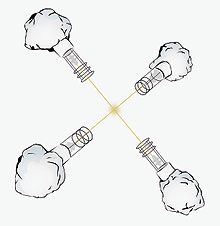
|
Quote: |
WATCH THE CLOCK
Precision timing is critical in this step. All the lasers should
be arranged to converge on the same point simultaneously in
order to create a uniform distribution of energy. However,
because the lasers will be widely separated in space, they are
also widely separated in time. The scientist need only ensure
that all the beams converge in the same place at the same
moment, not that they fire all at once. |
BUILD A COSMIC ATOM SMASHER
One of the most powerful energy-generating devices currently
available to scientists is the Large Hadron Collider, which, when it
becomes operational in 2007, will be able to generate 14 trillion
electron volts. Even that is one-quadrillionth the energy necessary
to create a false vacuum.
But a particle accelerator with the diameter of our solar system
might do the trick. Gigantic coil magnets could be placed at
strategic intervals on asteroids to bend and focus a particle beam
in a circular path around the sun. (Since the vacuum of empty space
is better than any vacuum attainable on Earth, the beam of subatomic
particles would not need light-years of tubing to contain it; it
could be fired into empty space.) Fair warning: The magnetic field
required by each coil to bend the beam would be so huge that the
surge of power through it might melt the coil, making it usable only
once. After the beam has passed, the melted coils would have to be
discarded and replaced in time for the next pass.
Alternatively, it is worth noting that the Large Hadron Collider may
be the last generation of giant particle accelerators to use radio-frequency
energies to boost subatomic particles around a giant ring.
Physicists are already attempting to build tabletop-size laser-driven
accelerators that, in principle, could attain billions of electron
volts. So far, scientists have used powerful laser beams to attain
an acceleration of 200 billion electron volts per meter, a new
record. Progress is rapid, with the energy growing by a factor of 10
every five years. Although technical problems hamper the development
of a true tabletop accelerator, an advanced civilization has
billions of years to perfect these and other devices.
In the interim, to reach the Planck energy with something like
current laser technology would require an atom smasher 10 light-years
long, reaching beyond the nearest star. Power stations would need to
be placed along the path in order to pump laser energy into the beam
and to focus it—a minor task for a Type III civilization.
7- SEND IN THE NANOBOTS
Assume now that the wormholes created in the previous steps prove
unworkable. Perhaps they are unstable, or too small to pass through,
or their radiation effects are too intense. What if future
scientists find that only atom-size particles can safely pass
through a wormhole? If that is the case, intelligent life may have
but one remaining option: Send a nanobot through the wormhole to
regenerate human civilization on the other side.
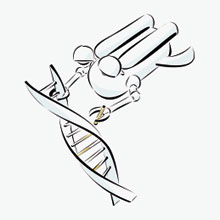
|
Quote: |
IF ALL ELSE FAILS
If an actual nanobot cannot squeeze through a tiny wormhole,
future scientists might still be able to thread enough
information through the wormhole to construct a nanobot on the
other side. |
This process occurs all the time in nature. An oak tree produces and
scatters seeds that are compact, resilient, packed with all the
genetic information necessary to re-create a tree, and loaded with
sufficient nourishment to make colonization possible. Using
nanotechnology, an advanced civilization might well be able to
encode vast quantities of information into a tiny, self-replicating
machine and send this machine through a dimensional gateway.
Atom-size, it would be able to travel near the speed of light and
land on a distant moon that is stable and full of valuable minerals.
Once situated, it would use the raw materials at hand to create a
chemical factory capable of making millions of copies of itself.
These new robots would then rocket off to other distant moons,
establish new factories, and create still more copies. Soon, a
sphere of trillions of robot probes would be expanding near the
speed of light and colonizing the entire galaxy.
Next, the robot probes would create huge biotechnology laboratories.
They would inject their precious cargo of information—the preloaded
DNA sequences of the civilization’s original inhabitants—into
incubators and thereby clone the entire species. If future
scientists manage to encode the personalities and memories of its
inhabitants into these nanobots, the civilization could be
reincarnated.
Mathematically, this is the most efficient way for a Type III
civilization to colonize a galaxy, not to mention a new cosmos. If
we ever encounter another intelligent life-form, chances are it
won’t be in a flying saucer like the starship Enterprise. More
likely, we’ll make contact with a robot probe they’ve left on a moon
somewhere. This was the basis of Arthur C. Clarke’s 2001: A Space
Odyssey, which may be the most scientifically accurate depiction of
an encounter with an extraterrestrial intelligence. In the film
version, this logic was originally articulated by scientists in the
film’s opening minutes, but director Stanley Kubrick cut the
interviews from the final edit.
| |
|
Quote: |
STRANGE BUT TRUE
Although seemingly fantastic, these scenarios are consistent
with the known laws of physics and biology and would be
within the capabilities of a Type III civilization. For a
civilization caught in the last days of an expanding
universe, these may be the only options for escape. |
|
|
Alýntý:http://www.edmitchellapollo14.com
Hiçbir
yazý/ resim izinsiz olarak kullanýlamaz!! Telif haklarý uyarýnca
bu bir suçtur..! Tüm haklarý Çetin BAL' a aittir. Kaynak gösterilmek ţartýyla siteden
alýntý yapýlabilir.
The Time Machine Project © 2005 Cetin BAL - GSM:+90 05366063183 -Turkiye/Denizli
Ana Sayfa /
index /Roket bilimi / E-Mail /CetinBAL/Quantum Teleportation-2
E-Mail /CetinBAL/Quantum Teleportation-2
Time Travel Technology /Ziyaretçi
Defteri /UFO Technology/Duyuru
Kuantum Teleportation /Kuantum Fizigi
/Uçaklar(Aeroplane)
New World Order(Macro Philosophy)/Astronomy
|